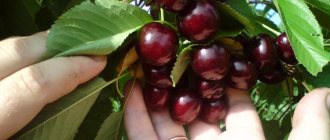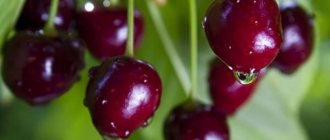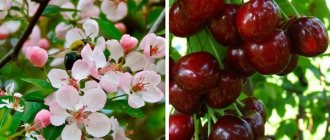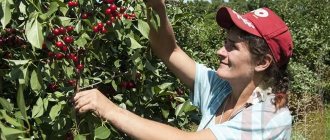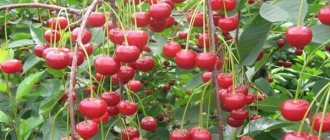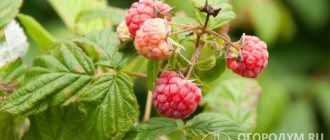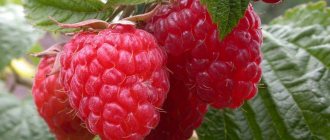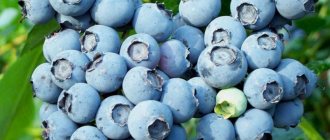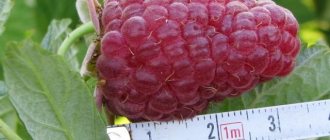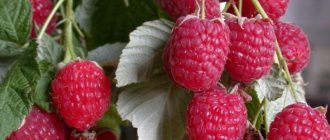Characteristics and description
The medium-sized tree and flower buds tolerate frosty winters well. Therefore, it can be grown without fear in those regions where winters can be as low as 40 degrees below zero. "Veda" has a late ripening period. To obtain a harvest, it is necessary to plant pollinator trees nearby.
The crown of “Veda” is round, thick and spreading. The shoots are pubescent and straight, gray-olive in color. The tree grows quickly. The leaves are matte, large, soft green in color, pointed, jagged along the edge and with thick petioles.
The ripe fruit is smooth, dark red, subcutaneous points are faintly visible. The berries are medium-sized, round in shape, weigh about 5 g. They taste sweet, tender and juicy. The bone separates well from the pulp. On average, fruiting begins after 4–5 years. At the end of July it begins to bear fruit actively. The berries are universal in purpose.
Advantages and disadvantages: is it worth planting on the site?
Among the positive characteristics of Veda cherries, experienced gardeners highlight:
- excellent consumer and product qualities;
- high degree of resistance to adverse environmental factors;
- frost resistance (up to -30 degrees);
- friendly ripening of fruits;
- fruit buds do not freeze;
- the degree of survival in a permanent place is excellent;
- relative unpretentiousness to growing conditions;
- possibility of cultivation in regions with cold climates.
But when growing this fruit crop, some disadvantages were noticed:
- the need for pollinating plants;
- drought resistance is average;
- protection from diseases and parasitic individuals is needed;
- long period of entry into fruiting.
Choosing a place
A favorable place for planting should not be a low-lying wetland where water accumulates after rains. But gentle slopes with good sunlight are more suitable. "Veda" loves warmth and light, which has a positive effect on the sweetness of the fruit.
The optimal planting density is 4 or 5 m. Trees should not touch each other with branches. Groundwater should be at a level of at least 1.5 m. If it is impossible to choose another location, make drainage grooves to remove excess moisture. Otherwise, the roots of the tree may begin to rot. Excess moisture slows down the growth and development of shoots.
"Veda" develops normally in sandy loamy loose soil, where access to oxygen is ensured. Sandy, acidic and heavy clay soils are less suitable for trees. You can improve the soil yourself: add a bucket of sand per 1 square meter. m with the addition of 500 g of lime.
Good neighbors for cherries: greens, flowers. And corn and sunflowers can shade the space and deplete the soil.
Time to board
Cherries should be planted when the root system is at rest, namely in the autumn or spring. In temperate climates, it is better to plant in early spring, as autumn planting may not have time to take root before frost sets in. In the southern regions it is permissible to plant in the fall, the main thing is no later than 2 weeks before the onset of cold weather. Seedlings planted in containers actively take root throughout the season.
If you purchased planting material in late autumn, dig it into the area. To do this, make a trench 40 cm deep with one inclined wall. Place the seedlings on it and sprinkle with earth, covering with spruce branches. This will protect the seedlings from rodents.
Choosing seedlings
Buy seedlings from trusted places where they grow crops. There, each plant undergoes control and has data on age and variety.
On a note! The best choice is annual and biennial seedlings.
Inspect the seedlings carefully. Two-year-old samples must have at least 3 skeletal roots, which have many fibrous processes, which should be free of rot and damage. The crown should have 3 side branches 50 cm long and a conductor. The trunk 10 cm from the root collar has a slight curvature - the grafting site.
We plant
3 weeks before the intended planting, it is necessary to prepare the site. Carefully dig up the soil, remove weeds and old rhizomes, and dig holes with a diameter of 60x80 cm. Mix the fertile soil layer with a bucket of humus, 140 g of superphosphate, 350 g of ash and 50 g of potassium sulfate.
- We fill part of the soil with fertilizers into a hole in the form of a slide.
- Place the seedling with straightened roots into the hole. Possible together with the container.
- Install the support.
- Cover with soil and compact so that the soil settles. The soil should fit tightly to the roots, and the root collar should be 5 cm above the soil.
- Form a circular hole and pour 2 buckets of warm water into it.
- Do not tie the tree tightly to the support.
- If you plant at the beginning of the season, trim the crown. There is no need to prune in the fall. You can shorten the shoots in the spring.
- At first, cover the seedling with agrofibre.
How to plant Iput cherries?
It is better to plant young trees in early spring (before the buds swell) or in the fall (after leaf fall). The weather during planting should be dry and calm, and the temperature should be above zero.
Stage one. Choosing seedlings
Cherry seedlings
Ideally, seedlings should be purchased immediately before planting. If we are talking about industrial production, then the trees should have a high trunk (about two meters), and if we are talking about private gardening, then no more than 50 centimeters. It is also desirable that the seedlings be zoned and at least two years old.
Where to buy seedlings
You can recognize a healthy seedling by the signs below.
The crown should be well developed. The same applies to the root system
In addition, the color of the root when cut should be cream. It is also important that the trees have three or four branches at least 35 centimeters long. The bark should be smooth; swelling, growths or spots are unacceptable. Finally, the diameter of the trunk must be at least 1.6 centimeters. If the bark on the seedlings is wrinkled, then you should not buy them, since this wrinkling indicates that the tree has been overdried
As a rule, such plants do not take root
If the bark on the seedlings is wrinkled, then you should not buy them, since this wrinkling indicates that the tree has been overdried. As a rule, such plants do not take root.
Transportation of cherry seedlings
Stage two. Choosing a place
Plant in an area with good drainage and loose soil. Ideally, this should be a well-lit area with loamy soil and an acidity level of 5.5 pH. Avoid places where there is stagnation of moisture and permanent flooding. Finally, the depth of groundwater should start from two meters.
Carefully choose a place to plant cherries
Stage three. Preparing the ground
When preparing, you can use one of two possible options.
Option #1. Five to six months before planting, take care of the planting site. Dig an 80-centimeter hole measuring 1x1 meter, mix the dug soil with five buckets of natural fertilizer (this can be manure, humus or compost) and 250 grams of superphosphate. Fill the hole with the prepared mixture.
Preparing the planting hole
Option #2. Prepare the hole two weeks before planting. Mix half of the dug soil with 20 kilograms of compost, 300 grams of ash and 30 grams of sulfuric potassium. Place the resulting mixture in the hole, and pour the other half of the soil on top.
Pit for planting cherries
Stage four. Planting trees (step by step instructions)
Planting cherries
First, remove all damaged roots, then follow the algorithm below.
Step one. Dig a hole about 80 centimeters in the planting hole.
Step two. Make a small hill at the bottom and place a peg in it.
Planting pit and planting seedlings
Step three
Lower the seedling, carefully straighten the root system
It is important that the neck is seven to eight centimeters above the ground level
Correct root position
Step four. Carefully fill the hole, lightly compacting the soil.
Step five. Tie the tree to the stake using twine.
Step six. After this, make a hole with a soil edge.
Planting cherries, forming a hole for watering
Step seven. Water the seedling (about 30-40 liters of water for each plant).
Step eight. When the water is absorbed, mulch with peat, shavings or fresh soil.
Tied and mulched seedling
It is important that the distance between seedlings is three to four meters, and between rows - about five meters
Rules for proper landing
Watering
Immediately after planting, it is enough to water the young seedlings with 30 liters of water once every 7 days. A tree that is actively bearing fruit needs to be moistened more - 3 times in 1 season, with 5 buckets of water. During drought, watering should be increased even more. As soon as the leaves fall, winter watering with 70 liters of water per tree is necessary. When the berries are just ripening, watering should be limited, otherwise the fruits may begin to crack.
- Using a hoe or other convenient means, make a ditch at least 15 cm deep around the trunk and along the perimeter of the crown and pour in water along the diameter of the ditch.
- You can water using a hose with a sprinkler and at the same time moisten the leaves. It is better to do this not in the scorching sun, but in the evening.
- For drip irrigation, lay the tape in a spiral around the trunk. The water itself will be well distributed to the important parts.
Attention! Control watering, remember excess moisture leads to rot and gradual death of the tree.
You can determine the watering level by squeezing the soil under the crown into a fist. If it does not crumble, then there is enough water in the soil.
Cherry care
Any cherry is quite capricious and demanding, taking a lot of time and effort from the gardener. Revna in this sense is a pleasant exception. But this does not mean that you can simply forget about the planted tree. To get the maximum possible harvest, you have to work hard.
Pruning and crown formation
Immediately cut off the top of the planted tree at a height of about 60–70 cm from the ground.
Basic principles of cherry crown formation:
- In early spring, immediately after the buds open (late April-early May), trim all frozen branches back to healthy wood.
- In summer, when young shoots reach a length of 50–60 cm, pinch their tops. Cherries tend to form too powerful growths that do not have time to ripen by winter and because of this they freeze out. Timely pinching improves the ripening of shoots.
- When the tree reaches 2–2.5 m in height, cut its central vertical shoot above the last weak horizontal side branch.
- Support branches if necessary. Try to avoid unnecessary shortening of branches; flower buds are mainly formed at their ends.
Video: description of proper tree pruning
Watering
Excess moisture is harmful to cherries and can cause disease outbreaks. Watering is only required in very dry summers, after flowering and after harvest. The water requirement is from 3 to 5–7 buckets per tree, depending on the age of the cherry. In the first or second year after planting, young seedlings are watered more often. In the absence of rain - 2 buckets 1-2 times a month. Dampness is especially harmful in late summer and autumn.
Fertilizer
Overfeeding any cherries is harmful! Revna is no exception. The shoots, “fatten” from excess nitrogen, attract pests and do not have time to ripen normally over the summer, as a result of which they freeze even in relatively mild winters. Only on the poorest soils is it advisable to add a bucket of rotted compost under each tree in the spring (in extreme cases, you can replace it with a complex mineral fertilizer like Kemira). Fertilizing is applied in strict accordance with the manufacturer's recommendations.
Shelter for the winter
Cherry is a heat-loving plant that prefers mild climates. Frosts below -30oC, sudden changes in daily temperatures, winter thaws and sunburn are destructive for it.
To protect against sunburn, whiten the trunks, forks and main branches of the cherry tree before winter.
In the Bryansk region and regions located to the south, Revna cherries are quite winter-hardy and do not require winter shelter. To protect against sunburn and sudden changes in daily temperatures, in the fall you can cover the trunks, skeletal forks and the lower part of large branches with a special garden whitewash that is not washed off by rain and snow. The white surface reflects the sun's rays, saving the bark from overheating. Another option is to wrap the trunks and main branches with a white covering material like agril or spunbond that is highly breathable.
To protect against hares and other rodents, use a special net.
A special mesh will reliably protect trees from hares, mice and other rodents who in winter are not averse to feasting on the fragrant wood of fruit trees
In the Central region, Revna cherries are zoned only in the Bryansk region, where winters are much milder and warmer than in the Moscow region. In some protected areas within Moscow and in the southern regions of the Moscow region, it can grow without shelter. In gardens with a less favorable microclimate, trees often freeze. An additional problem is created by the tendency of cherries to warm the bark from dampness during winter thaws. Because of this, it is unacceptable to cover trees with snow, earth, and especially manure.
Cover cherries correctly:
- In October-November, when the temperature drops steadily to zero degrees, build a pyramid frame made of metal reinforcement or wooden slats around the tree. Attach it firmly to the ground to prevent the structure from being knocked over by the wind.
- Wrap the frame overlapping with agril or spunbond in several layers, depending on the density of the covering material. Tie a rope on top. Press the bottom edge tightly to the ground with bricks.
- After heavy wet snowfalls or strong winds, be sure to check the safety of the shelter.
- In April, immediately after the snow melts, immediately remove the shelter.
Fertilizers
Lack of nutrition will negatively affect the overall development of the tree. Throughout the season, do not forget to fertilize. And the appearance of the cherry will tell you what it is missing at the moment:
- Did the leaves fall early? The tree lacks iron.
- Have the leaves dried out or become deformed? The tree needs boron.
- Are there small brown spots on the leaves? Have the shoots started to dry out? Cherries need copper.
- Are the leaves getting smaller? Add zinc.
The first year the tree develops quietly without fertilizing, if useful elements were initially added to the soil. Next spring, for active growth of the crown and root system, you need 60 g of ammonium nitrate diluted in 10 liters of water. After 2 weeks you should add 2 tbsp. l of urea diluted in 11 l of warm water. And in September, replenish 2 tbsp. l of potassium solution per 10 l of water.
Fertilizers for cherries need to be applied at least 5 times:
You may be interested in: Rules for pruning cherries and diagrams by age How to properly care for cherries in the autumn How to plant cherries correctly
- At the end of March, add per 1 sq. m of soil 20 g of ammonium nitrate.
- Before flowering begins, add 50 g of superphosphate per 10 liters of water, and after flowering 50 g of nitrophoska per 10 liters of water.
- After harvesting the fruits, the tree needs to regain its strength. To do this, feed it with 100 g of potassium sulfate + 100 g of superphosphate + 10 liters of water.
- Before cold weather, add humus to the soil.
- Liquid fertilizers for spraying have a good effect on the root system and the formation of ovaries: Agricola and Zdraven - Aqua.
- In spring, cherries need nitrogen, so you can add 3 kg of mullein per 30 liters of water or 2 kg of chicken manure per the same amount of water.
- Organic replenishment can be done by planting peas in a planting groove under a tree, and in the fall they are mowed and plowed.
Trimming
Cherries should be formed according to the sparse-tiered type. Maintain a gap of 0.5 m between the tiers and 3 skeletal branches in each tier . As soon as you have finished planting, shorten the conductor so that it becomes 5 buds longer than the side branches. Often, a shoot may grow at the base of the trunk at an acute angle, which is best removed.
As the second season begins, cut off the branches on the bottom row and leave the 3 strongest ones and cut them by a third. Cut the central shoot from the bottom row at a level of 1 m. When pruning in the spring, in the 3rd year, form a second tier of 3 shoots. At a height of 1 m from the second row, shorten the conductor.
Next season, leave 3 branches on the last tier.
Over the years, the cherries will bear fruit weaker, and the crown will grow stronger. Thread the crown and remove old branches, thereby rejuvenating the tree. In spring, 5-year-old branches should be replaced with young lateral shoots. As soon as the leaves fall, it is better to remove the dried branches.
History of the Veda variety
Back at the end of the 19th century, I.V. Michurin began work on growing frost-resistant varieties of cherries. In the 30s of the 20th century, 13 winter-hardy varieties were obtained, but all of them were small-fruited and produced small yields. Russian scientists continued to conduct breeding work. M.V. is recognized as the leader of domestic selection. Kanshina. At the All-Russian Lupine Research Institute, she and her colleagues created 14 new winter-hardy cherry varieties, including Veda.
Cherry Veda - winter-hardy variety of Russian selection
Preparing for frost
In general, “Veda” is a frost-resistant cherry. For the first 3 years the tree is still tender, so it will need insulation. After watering and mulching the soil, cover it with agrofibre or pine needles. To prevent cherries from rotting, insulate them at zero temperature. If the temperature rises 5 degrees higher, then it is better to remove the insulation.
When temperature changes during the day, there is a risk of damage to the bark, and this can contribute to the onset of fungal diseases. And to avoid sunburn, whitewash the trunk and skeletal branches with lime, adding insecticides to it.
The most large-fruited and productive late varieties
At a time when the entire harvest of early cherries has already been eaten and processed, late-ripening varieties begin to bear fruit very opportunely. The berries on such trees ripen towards the end of summer, and the most frost-resistant of them produce a harvest in the last ten days of August.
Vystavochnaya is an incredibly productive variety that ripens in July. Tall trees produce many large (up to 8 g) and very beautiful oval-shaped amber-carmine berries with wonderful taste. Exhibition cherry is distinguished by its increased frost resistance of flower buds, but is not capable of self-pollination. The best pollinators for it are the Recordistka, Cassini rannyaya and Rynochnaya varieties.
Bryansk pink is a late-ripening, self-sterile variety with good yield, valued for its low and compact trees, highly resistant to fungal diseases and winter frosts. The medium-sized (up to 5.5 g) berries of a beautiful light scarlet hue with dense amber pulp are distinguished by their sweetness and juiciness, and in addition, they hardly crack and are perfectly preserved during transportation.
Napoleon is a very old and excellently productive variety of European selection, released in Dagestan at the beginning of the last century. Tall trees delight with large (up to 7 g) almost black berries and a very good, sweet taste of dense pulp, diluted with light sourness. Napoleon cherries are universal in use, resistant to winter frosts and fungal diseases, and have excellent shelf life and transportability.
Regina is a self-fertile late cherry, characterized by compact, low trees with very high frost resistance and good yield. Large (up to 10 g) berries of a very beautiful dark garnet color delight with their bright taste and excellent transportability. The fruits are able to remain intact for a long time after ripening and not crack during the rainy season. An additional advantage of the variety is its early fruiting: the first harvest ripens already in the third year of the growing season.
Prevention and treatment of diseases
For clasterosporiasis, when the leaves are affected by spots that will eventually turn into holes, you need:
- plant healthy seedlings,
- thin out the crown
- remove damaged branches,
- before and after flowering, treat with 100 grams of 1% Bordeaux mixture diluted in 1 liter of water. After 2 weeks, the procedure should be repeated.
For gray rot, when the shoots are affected by gray growths and the fruits begin to rot, the following measures are needed:
- do the trimming
- monitor the nitrogen level, it may be exceeded,
- Sprinkle the soil and tree with 3% iron sulfate,
- After flowering, treat with 1% Bordeaux mixture.
To prevent gum disease, when a viscous mass appears on the branches or trunk, you must:
- reconsider the pruning process, you may have injured the tree,
- do not apply too much fertilizer,
- treat the wounds with a 1% solution of copper sulfate.
For powdery mildew, when a dirty coating forms on the leaves and bark, you should:
- water regularly,
- fertilize with products containing potassium and phosphorus,
- before flowering, treat with 2 ml of Topaz diluted in 10 liters of water,
- after flowering, treat with Hom 1%,
- in autumn, treat with 1% Bordeaux mixture.
Pest Control
To get rid of cherry flies, dig up the soil along the diameter of the crown in the fall, purchase glue traps, and after flowering, spray 1 ml of Spark diluted in 5 liters of water or 2 g of Aktara diluted in 10 liters. Repeat the procedure after a week.
To get rid of weevils, shake off the beetles from the branches and destroy them, sprinkle 10 g of fufanon diluted in 10 liters of water.
To get rid of aphids, pay attention to the presence of ants. They can be its carriers. If they are, then treat the surface with anti-them agents: Anteater or Cypermethrin. After getting rid of them, treat the affected parts with an infusion of onion peels made at the rate of 20 g x 10 liters of water or 2 g of Aktara diluted in 10 liters.
Diseases and pests of Veda cherries
The Veda variety has high immunity to major diseases and crop pests. Fungal diseases are dangerous for her: moniliosis, coccomycosis, klyasterosporiosis. The first signs of damage are dark spots on fruits and leaves, drying out of shoots. When they appear, diseased elements of the tree are eliminated and the cherries are sprayed with copper oxychloride, a solution of the drug Hom or Horus.
Pests that pose a danger to the crop include aphids, codling moths, and cherry flies. The insecticides Actellik, Iskra, and Karbofos work well against insects. For prevention in the fall, fallen leaves are removed and burned, and the soil in the tree trunk is dug up.
Reviews
Glafira: I planted Veda for the first time. I saw many advantages: the fruits are beautiful, dark, shiny and large, and can withstand frosts, even over 35 degrees. “Tyutchevka” grows nearby and, it turns out, they mature at the same time. All summer my whole family feasted on delicious cherries. Only one misfortune - birds. Therefore, you need to eat them as quickly as possible. Give it a try.
Taisiya: Veda seedlings were given to me by a neighbor. Such a beautiful tree, especially at the moment of flowering and fruiting. The flowers smell so nice, and the berries are a separate work of art. I make compotes from them both for the winter and in hot weather to cool down. She never got sick, and pests did not eat her. I water it as expected, loosen it and apply phosphorus and potassium fertilizers.
The most popular varieties of cherries
As with all stone fruit crops, the winter hardiness of flower buds and the winter hardiness of wood in cherries are inherited separately: a variety can be winter hardy as a whole, but with flower buds that freeze annually, and vice versa.
Among the varieties that are winter-hardy in both respects, we note the following: Fatezh (VSTISP, Moscow), Bryanskaya Rozovaya, Veda, Tyutchevka, Iput, Revna. yellow cherry
In terms of fruit quality, the varieties of the Non-Chernozem Zone are close to the southern ones, the largest-fruited ones produce cherries weighing more than 5 g: Sadko, Lyubimitsa Astakhova, Pamyat Astakhova, Iput, Tyutchevka, Raditsa, Revna.
There are two types of berries according to their consistency:
- Bigarro - with dense, gristly pulp - is more valuable and is stored for a long time;
- gini - with delicate, soft fruits - are less transportable and are more common among early ripening ones.
Cherry fruits are very healthy. They contain from 7 to 18% sugars, fiber, pectin, organic acids, and vitamins. Sweet cherries improve immunity, improve digestion, and dark fruits also have an anti-sclerotic effect.
